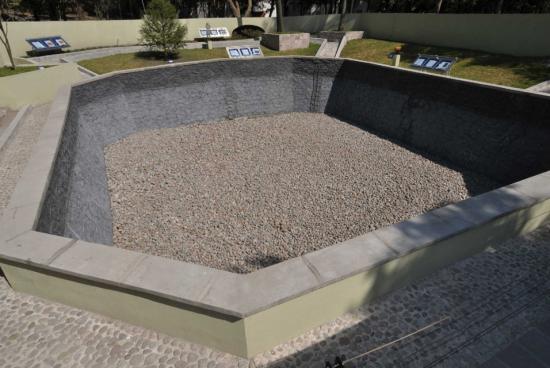Source - http://www.artdaily.org/index.asp?int_sec=2&int_new=63022#.Ua4YNkBM91A

The baths of Moctezuma. Photo: Meliton Tapia/INAH.
At the foot of the Chapultepec hill, specialists of the National Institute of Anthropology and History (INAH) have found archaeological evidence of a hydraulic system that used to provide water to the City of Mexico, they explained during the Historical Archaeology Symposium at the National Museum of History “Chapultepec Castle” (MNH).
The archaeologists Lourdes Lopez Camacho, from MNH and Guadalupe Espinosa, from the INAH Center in Veracruz, approached the following subjects: The fountains in aqueducts, the case of the fountain of Chapultepec and How were the baths of Moctezuma in Chapultepec discovered?, respectively. Lopez Camacho said that historical archaeology in the hill of Chapulin has aided in documenting the way that ancient inhabitants of the Valley of Mexico had a true adoration for the woods and the water of Chapultepec, which dates back to the Teotihuacan epoch (100 BC through 600 AD). “Chapultepec was a sacred place. Ancient rulers, such as Moctezuma Ilhuicamina, Ahuizotl and Moctezuma Xocoyotzing, used to have temples and resting homes there, just like Texcoco, where Nezahualcoyotl, whom colonial chronicles attribute the construction of a pre Hispanic aqueduct that provided the Great Tenochtitlan with water”, explained the archaeologist. She added that the first aqueduct, made of reeds, stones and mud, was begun in 1418, a year after the death of Chimalpopoca, which marks the rise of the Mexica elite. By the ruling epoch of Moctexuma I, with the outlines of Nezahualcoyotl, they began the construction of the Stone channel, between the years 1454 and 1466. Espinosa said that in general, the whole complex in the hill of Chapulin had a ritual, housing and recreational use for tlatoanismexican: “The chronicles mention that Moctezuma Xocoyotzin had a collection of exotic fish here”. After the Conquest, the crystalline water pond served as a pool for Hernan Cortes and Malinche, for the Spanish viceroys of the New Spain; it was also used by cadets of the Military School (XIX century), the emperor Maximilian of Habsburg and his wife, the empress Charlotte of Belgium, General Porfirio Diaz, among other important characters. The excavations allowed the rescue of “archeological teotihuacan material (100 BC through 600 AD), the Coyotlatelco phase (600 through 750 AD), the Aztec period I – IV (850 through 1521 AD), the colonial epoch (centuries XVI, XVII, XVIII), as well as the XIX century and the beginning of the XX century. The specialist added that since the colonial epoch “there have been many legends that there was a great treasure buried in the baths of Moctezuma, however this was proven to be untrue. Archaeologist Maria de la Luz Moreno, in 1999, excavated the site and only found pre Hispanic ceramic, glass, mud recipients, colonial objects and bones, but no treasure”.
Copyright © artdaily.org